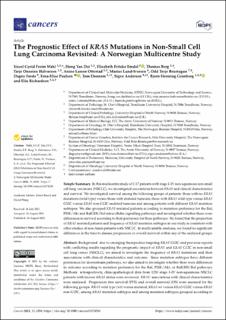The prognostic effect of KRAS mutations in non-small cell lung carcinoma revisited: A norwegian multicentre study
| dc.contributor.author | Wahl, Sissel Gyrid Freim | |
| dc.contributor.author | Hong, Yan Dai | |
| dc.contributor.author | Emdal, Elisabeth Fritzke | |
| dc.contributor.author | Berg, Thomas | |
| dc.contributor.author | Halvorsen, Tarje Onsøien | |
| dc.contributor.author | Ottestad, Anine Larsen | |
| dc.contributor.author | Lund-Iversen, Marius | |
| dc.contributor.author | Brustugun, Odd | |
| dc.contributor.author | Førde, Dagny | |
| dc.contributor.author | Paulsen, Erna-Elise | |
| dc.contributor.author | Donnem, Tom | |
| dc.contributor.author | Andersen, Sigve | |
| dc.contributor.author | Grønberg, Bjørn Henning | |
| dc.contributor.author | Richardsen, Elin | |
| dc.date.accessioned | 2021-09-28T07:30:51Z | |
| dc.date.available | 2021-09-28T07:30:51Z | |
| dc.date.created | 2021-09-13T09:36:07Z | |
| dc.date.issued | 2021 | |
| dc.identifier.citation | Cancers. 2021, 13 (17), 1-19. | en_US |
| dc.identifier.issn | 2072-6694 | |
| dc.identifier.uri | https://hdl.handle.net/11250/2783914 | |
| dc.description.abstract | Background: due to emerging therapeutics targeting KRAS G12C and previous reports with conflicting results regarding the prognostic impact of KRAS and KRAS G12C in non-small cell lung cancer (NSCLC), we aimed to investigate the frequency of KRAS mutations and their associations with clinical characteristics and outcome. Since mutation subtypes have different preferences for downstream pathways, we also aimed to investigate whether there were differences in outcome according to mutation preference for the Raf, PI3K/Akt, or RalGDS/Ral pathways. Methods: retrospectively, clinicopathological data from 1233 stage I–IV non-squamous NSCLC patients with known KRAS status were reviewed. KRAS’ associations with clinical characteristics were analysed. Progression free survival (PFS) and overall survival (OS) were assessed for the following groups: KRAS wild type (wt) versus mutated, KRAS wt versus KRAS G12C versus KRAS non-G12C, among KRAS mutation subtypes and among mutation subtypes grouped according to preference for downstream pathways. Results: a total of 1117 patients were included; 38% had KRAS mutated tumours, 17% had G12C. Among KRAS mutated, G12C was the most frequent mutation in former/current smokers (45%) and G12D in never smokers (46%). There were no significant differences in survival according to KRAS status, G12C status, among KRAS mutation subtypes or mutation preference for downstream pathways. Conclusion: KRAS status or KRAS mutation subtype did not have any significant influence on PFS or OS. | en_US |
| dc.language.iso | eng | en_US |
| dc.publisher | MDPI | en_US |
| dc.rights | Navngivelse 4.0 Internasjonal | * |
| dc.rights.uri | http://creativecommons.org/licenses/by/4.0/deed.no | * |
| dc.title | The prognostic effect of KRAS mutations in non-small cell lung carcinoma revisited: A norwegian multicentre study | en_US |
| dc.type | Peer reviewed | en_US |
| dc.type | Journal article | en_US |
| dc.description.version | publishedVersion | en_US |
| dc.source.pagenumber | 1-19 | en_US |
| dc.source.volume | 13 | en_US |
| dc.source.journal | Cancers | en_US |
| dc.source.issue | 17 | en_US |
| dc.identifier.doi | 10.3390/cancers13174294 | |
| dc.identifier.cristin | 1933602 | |
| cristin.ispublished | true | |
| cristin.fulltext | original | |
| cristin.qualitycode | 1 |
Tilhørende fil(er)
Denne innførselen finnes i følgende samling(er)
-
Institutt for klinisk og molekylær medisin [3426]
-
Publikasjoner fra CRIStin - NTNU [37169]
-
St. Olavs hospital [2440]

